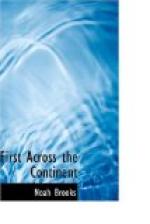“At noon the two canoes were finished. They were twenty-eight feet long, sixteen or eighteen inches deep, and from sixteen to twenty-four inches wide; and, having lashed them together, everything was ready for setting out the next day, Gibson having now recovered. Sergeant Pryor was directed, with Shannon and Windsor, to take the remaining horses to the Mandans, and if he should find that Mr. Henry (a trading-post agent) was on the Assiniboin River, to go thither and deliver him a letter, the object of which was to prevail on the most distinguished chiefs of the Sioux to accompany him to Washington.”
On a large island near the mouth of a creek now known as Canyon Creek, the party landed to explore an extensive Indian lodge which seems to have been built for councils, rather than for a place of residence. The lodge was shaped like a cone, sixty feet in diameter at the base and tapering towards the top. The poles of which it was constructed were forty-five feet long. The interior was strangely decorated, the tops of the poles being ornamented with eagles’ feathers, and from the centre hung a stuffed buffalo-hide. A buffalo’s head and other trophies of the chase were disposed about the wigwam. The valley, as the explorers descended the river, was very picturesque and wonderful. On the north side the cliffs were wild and romantic, and these were soon succeeded by rugged hills, and these, in turn, by open plains on which were descried herds of buffalo, elk, and wolves. On the twenty-seventh of July, having reached the Bighorn, one of the largest tributaries of the Yellowstone, the party have this entry in their journal:—
“They again set out very early, and on leaving the Bighorn took a last look at the Rocky Mountains, which had been constantly in view from the first of May. The (Yellowstone) river now widens to the extent of from four hundred to six hundred yards; it is much divided by islands and sandbars; its banks are generally low and falling in; it thus resembles the Missouri in many particulars, but its islands are more numerous, its waters less muddy, and the current is more rapid. The water is of a yellowish-white, and the round stones, which form the bars above the Bighorn, have given place to gravel. On the left side the river runs under cliffs of light, soft, gritty stone, varying in height from seventy to one hundred feet, behind which are level and extensive plains. On the right side of the river are low extensive bottoms, bordered with cottonwood, various species of willow, rose-bushes, grapevines, redberry or buffalo-grease bushes, and a species of sumach; to these succeed high grounds supplied with pine, and still further on are level plains. Throughout the country are vast quantities of buffalo, which, as this is the running-season, keep up a continued bellowing. Large herds of elk also are lying on every point, so gentle that they may be approached within twenty paces without being alarmed. Several beaver were seen in the course of the day; indeed, there is a greater appearance of those animals than there was above the Bighorn. Deer, however, are by no means abundant, and antelopes, as well as bighorns, are scarce.”




